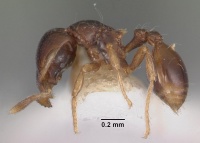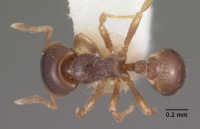Strumigenys siagodens
| Strumigenys siagodens | |
|---|---|

| |
| Scientific classification | |
| Kingdom: | Animalia |
| Phylum: | Arthropoda |
| Class: | Insecta |
| Order: | Hymenoptera |
| Family: | Formicidae |
| Subfamily: | Myrmicinae |
| Tribe: | Attini |
| Genus: | Strumigenys |
| Species: | S. siagodens |
| Binomial name | |
| Strumigenys siagodens (Bolton, 2000) | |
Known only from the type collection.
Identification
Bolton (2000) - A member of the Strumigenys appretiata-group. Among the majority of species of this group that retain a properly shaped ventral spongiform lobe on the postpetiole it is smallest and least easily visible in siagodens. The lobe is of normal shape, with a rounded-convex ventral margin, but is very reduced in size and by no means conspicuous.
Of the two species that retain a minute vestige of the lobe Strumigenys hadrodens contrasts with siagodens as the former has very short faint basigastral costulae, has the apical half of the first gastral tergite sculptured , has short straight hairs on the gaster, but lacks reticulate-punctate sculpture on the dorsal alitrunk and dorsal petiole node. Strumigenys appretiata is smaller than siagodens , with the pronotum virtually unsculptured and the basigastral costulae short, sparse and widely spaced.
Keys including this Species
Distribution
Latitudinal Distribution Pattern
Latitudinal Range: -22.809943° to -22.809943°.
| North Temperate |
North Subtropical |
Tropical | South Subtropical |
South Temperate |
- Source: AntMaps
Distribution based on Regional Taxon Lists
Neotropical Region: Argentina, Paraguay (type locality).
Distribution based on AntMaps
Distribution based on AntWeb specimens
Check data from AntWeb
Countries Occupied
| Number of countries occupied by this species based on AntWiki Regional Taxon Lists. In general, fewer countries occupied indicates a narrower range, while more countries indicates a more widespread species. |

|
Estimated Abundance
| Relative abundance based on number of AntMaps records per species (this species within the purple bar). Fewer records (to the left) indicates a less abundant/encountered species while more records (to the right) indicates more abundant/encountered species. |

|
Biology
Castes
Nomenclature
The following information is derived from Barry Bolton's Online Catalogue of the Ants of the World.
- siagodens. Pyramica siagodens Bolton, 2000: 163 (w.) PARAGUAY. Combination in Strumigenys: Baroni Urbani & De Andrade, 2007: 128
Unless otherwise noted the text for the remainder of this section is reported from the publication that includes the original description.
Description
Worker
Holotype. TL 2.0, HL 0.59, HW 0.52, CI 88, ML 0.10, MI 17, SL 0.24, SI 46, PW 0.28, AL 0.56. Pronotal humeral hair long, fine and flagellate. Mesonotum with a single pair of long fine standing hairs that are flexuous to flagellate. First gastral tergite with long fine flexuous to flagellate hairs. Pronotal dorsum mostly glossy and with faint, quite dense longitudinal striolae that run the length of the segment but are more distinct posteriorly. Mesonotum feebly reticulate-punctate and with traces of striolate sculpture. Upper half of propodeal declivity, and dorsum of petiole node reticulate-punctate. Basigastral costulae fine, longer than dorsal length of postpetiole disc but not extending half the length of the tergite; first gastral tergite otherwise smooth and shining. Propodeal spines short, acutely triangular. Petiole node in dorsal view slightly broader than long, the lateral petiolar lobes reduced to a small dentiform prominence on each side at the posterolateral angle. Lateral spongiform lobe of postpetiole present but very reduced, retaining a short convex ventral margin but distinctly very much smaller than the lateral lobe that overhangs it.
Paratypes. TL 2.0-2.1, HL 0.56-0.60, HW 0.50-0.54, CI 86-90, ML 0.10-0.12, MI 15-17, SL 0.22-0.25, SI 46-50, PW 0.26-0.30, AL 0.54-0.59 (4 measured). No single specimen appears to show complete pilosity. In particular the fine gastral hairs seem very prone to loss by abrasion.
Type Material
Holotype worker, Paraguay: Itapua, San Rafael, 6.xi.1983, no. 82/23 (c. Dlouhy) (Musee d'Histoire Naturelle Genève). Paratypes. 4 workers with same data as holotype (The Natural History Museum, Museum of Comparative Zoology).
References
- Baroni Urbani, C. & De Andrade, M.L. 2007. The ant tribe Dacetini: limits and constituent genera, with descriptions of new species. Annali del Museo Civico di Storia Naturale “G. Doria”. 99:1-191.
- Bolton, B. 2000. The ant tribe Dacetini. Memoirs of the American Entomological Institute. 65:1-1028. (page 163, worker described)
References based on Global Ant Biodiversity Informatics
- Fernández, F. and S. Sendoya. 2004. Lista de las hormigas neotropicales. Biota Colombiana Volume 5, Number 1.

